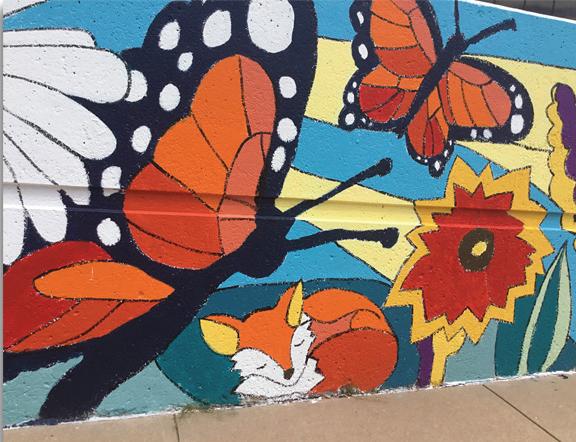
21 minute read
Finding Love in Ponca City


Advertisement
Story & Interviews by Kelsey Wagner/Editor-in-Chief

Love is a powerful word. People write books and make movies about it, people gossip about who is in it, wars have been fought over it and its a world that almost every person says at least one time to someone in their life. Love has so many meanings to so many people.
But love has new meaning when it comes to children and families. Love does not always translate to nuture and care. Parents can, at times, struggle to care for their own children.
At possibly the lowest point of any child’s life, when they are taken away from everything they know, they put into the care of others.
All across Ponca City, in homes, apartments, perhaps even next door, foster families are taking in children, wrapping their arms around them and loving these children in their greatest time of need. Foster families often receive no recognition - there are no awards for a lifetime dedication to foster care.
In the month of love, we wanted to explore a different take on the tradiational love story. These are just a few of the foster care workers, supporters and families strive every day not just to help foster children be care for, but to help them find love in Ponca City.

Sarah Pickup and Jamie Phillips Marland’s Place
Marland’s Place is a unique organization that specializes in foster care support. Jamie Phillips, CEO of the recently rebranded organization, formerly Marland’s Children’s Home, says that she has seen a huge uptick in families reaching out to become foster homes.
“I’ve seen a huge increase in the number of people who are actually responding and reaching out. We have so many families to process, which is a super good problem to have!” said Jamie.
Kay County is the third largest for numbers of foster children in the care of the state, directly behind Tulsa and Oklahoma counties.
Just two short years ago, the Marland’s Children Home functioned as a group home, but due to continued budget cuts and the sheer complexity of running the group home, the board decided to shift their focus to supporting foster families. With a large campus with room to grow, they set their mind and mission to provide support and housing to families that wanted to foster.
“We have five apartments on campus, and they have been full the entire year,” Jamie said.
Marland’s Place is not the only foster agency providing housing for foster families, but Jamie says they are rare, with only two other agencies in the state with similar housing available.
They are in the process of building five more foster family apartments, but the process to raise money and build is long. Because of the high demand, they are looking for other ways to provide housing. A recent bequest of a house located in Ponca City will provide one more home, while the others are being built.
Having enough space to foster children can be a limitation, and by removing that barrier, it can open foster care opportunities to those who would not otherwise have the ability.
Another reason why the on-campus housing was made available is because it enables sibling sets, who are more often than not separated, to be kept together.
Sarah Pickup works at Marland’s Place as the Director of Development. She lives, eats and breathes foster care, something she has always been passionate about. Her goal is to help raise funds to support the mission of the organization, but when she’s not working, she’s home caring for own foster children. Sarah has been a foster parent since 2012. Sarah has had 10-12 placements – no more than three at a single time.
Sarah says they answer questions from curious families all the time, and they see the common misconceptions about foster care. She says that it is a big commitment, but that foster families actually have a lot of choice in what type of care they offer and the ages and number of children they take.
“There’s different types of foster care, and if they don’t want commitment to longer term, they can just be emergency placement, meaning as soon as a child is brought into custody that child can stay with them anywhere from 24 hours to 3 weeks, or until a more permanent solution is found,” says Sarah, adding, “there really are a bunch of options with foster care, whether that’s with age, gender, whatever you are comfortable with and that can also change over time.”
There are all types of foster parents and the requirements to become certified are fairly simple. Foster parents must be 21 years of age, have a dedicated space for the child that includes a bed, and a place for their belongings and must be able to properly care for the child while they are in the home. Food, toys and a caring adult to look after a child who is experiencing one of the most traumatic experiences of his/her entire life.
There are many misconceptions about the requirements, but Sarah says many of those are false. For example, foster parents can be single or married, rent or own, same sex or heterosexual marriage, have children or no children. People who have had previous child welfare issues are not accepted, as well as some criminal offenders. All foster parents do have to pass a background check, and while a criminal background can be a disqualifier, Sarah says that is not always the case.
“Sometimes that can be negotiable, so I don’t want people to hesitate to at least try if it’s something they want to do,” says Sarah.
It generally takes up to six months to become a certified foster parent. There is a lot of paperwork involved, followed by a home assessment and a home study. A neutral third party comes into the home and reviews the living conditions, background, family of original, finances and any possible traumas that might be present in the home. If the home study finds the foster parents to meet criteria, they will then begin their training.
“It is a time commitment; it is. It is six months of paperwork, home study, training; but in the end, it’s worth it. It does pay off,” says Sarah.
Where Marland’s Place comes in, is as a resource for the foster families. In addition to providing the training, they also provide a way for foster families to connect and network together. Though COVID-19 has put a damper on their social events, Jamie says that their social events help set them apart from other agencies.
Marland’s Place also has an “on-call” phone that is manned 24 hours a day. The phone is there for their foster families to call in case of any emergency, but Jamie says that is the role their agency plays, to be there for any needs to support their foster families.
“There are times that some children come in with specific needs, and we may need to connect them with an occupational therapist or a physical therapist; but as there is a need, we find gaps to fill those needs,” Jamie says.
Sarah says she is asked questions all the time about what it’s like to give children up after having them for a short time.
The most common reaction is, “I could never do that, I would get too attached!”
“Those are the parents that need to be foster parents. We are looking for people who are willing to get attached and love wholeheartedly and fiercely, and just love these kiddos. Usually, they do require a lot of time and attention, and they have needs that are higher than kids in general. It’s important that they pour into these kids, and they do get attached. There are days when it’s hard when that baby or kid leaves, but you also have to look at the side of reunification for that family, which is always the goal.”
Sarah says that reunification makes it all worth it. For either a mother or father who has met the threshold to regain custody of their children, as difficult as giving up the child may be, the thrill of knowing the child is back home makes it all worthwhile.
With the emotional highs and lows that come with foster care, the process can seem overwhelming. But the time put in can make a real difference in that child’s life. It could be that the child is going back to a home or family that is still not completely stable and the time spent in the home of the foster family, is the only stability they may ever see, making its impact all the more valuable.
“These kids have been through some real trauma. What these children need for a healthy start in life is for someone to get attached to them. It’s so important,” says Jamie.
Sarah has advice for anyone looking to get into foster care, advice that she herself has taken to heart:
“If you love fiercely, there are no regrets.”
Marland’s Place is a 501c3 nonprofit organization. To make a donation, visit them online at MarlandsPlace.com

Markesha Collins-Duggan, DHS
Markesha is in Recruitment and Development in the Foster Resource Unit of the State of Oklahoma Department of Human Services. She’s been working with foster care families for over five years but has worked with the state of Oklahoma for over 20.
The largest issue, she says, at the current are that there are more children that need homes than there are homes available in Kay County. Many children in Kay County, more than half in fact, are shipped out of the county: away from their school; away from their siblings; and at times, out of reach for visitation.
In Kay County, at this moment, there are only 22 traditional foster homes available to take placements. There are times when kinship placements are options, but for many children, there are no kinships available to take them.
Markesha describes what happens when siblings are separated out of county.
“Let’s just say it’s a sibling group of three, and we don’t have enough beds, and they have to be placed out of county. We may have one sibling placed in Comanche County, which is in Lawton; we may have another sibling in Garfield County, and one placed in Tulsa County. Now just imagine facilitating visitation on any given day, to either see their parents or seeing each other as siblings! It just creates a lot of barriers for that family to reunify and keep that connection. On top of that, you have a social worker running all over the state just to pick up and facilitate those visits,” says Markesha.
“You just think about the trauma of that removal initially anyway, and then you have the second trauma of them losing their friends, their school, their church,” Markesha says.
Markesha says the need of foster homes is great, but that the process to get certified for most is fairly easy.
“It starts with a phone call. Many people just have questions,” and Markesha says she is available all the time to answer those questions. She says it can take some people years to come to the decision to actually begin the process after their first phone call.
Some foster homes can be certified in as little as 90 days if there are no issues.
Foster care is open to most adults, and even though foster parents must be over the age of 21 to have a foster child, there is no upper age limit. All applicants must pass a medical exam and be physically able to care for a child, so they leave that determination up to a medical professional.
Most new foster families, Markesha says, simply need support, and if they can’t get ahold of their social worker for the child, she is the point person to answer all their questions. There are also virtual support groups that have been meeting in lieu of in-person meetings because of COVID-19.
Most new foster families, Markesha says, simply need support, and if they can’t get ahold of their social worker for the child, she is the point person to answer all their questions. Markesha encourages the families and directs them to any other additional resources but says that even though there are requirements to care for the children, when you boil it down the most important thing they need is love.
“You are not just helping a child; you are helping a FAMILY. It’s very rewarding if people will just think about the children. We have such a huge need. We do not have enough beds in our home county,” says Markesha, “and can’t we help lessen that trauma by at least keeping them in Kay County?”
For more infomation, please call Markesha at 580-362-7167 or visit okfosters.org.

David and Tina Havens
22 years ago, Tina and David decided they wanted to become foster parents. David’s parents fostered, and his now grown daughter has become a foster parent.
“We just thought it would be a good thing to do,” says Tina, sweetly.



Tina and David have fostered over 75 children in 22 years, and of those 4, they have adopted 4. They have biological children between them, which were raised alongside their foster children.
Tina says not much has changed in 22 years, except perhaps the invert of phones with makes children more distracted and less personable than they used to be.
Tina says they have utilized their ability to choose what types of children they can take, because their family situation has changed as they have gotten older.
“We used to have kids of all ages, up to 5 or 6 kids under the age of 6 years old. Now that we’ve gotten older, we take maybe one or two at a time, and we try to stay between the ages of 6 and 10. That’s just where we are right now,” says Tina, indicating that their needs will likely continue evolving over time.
Tina says that she had all types of children over the many years, some with worse traumas than others. Tina and David are a team, and tag team when the other parent is tired. Tina says she’s learned a lot in 22 years and has found that keeping the kids busy with activities is the most tried and true way to keep them engaged, but it’s even more rewarding for herself.
“One of the nicest things is to see a child do something for the first time, and that could even be a 10-year-old. We’ve had some kids that had never been to the zoo, never signed up for any sports, never swam or didn’t know how to swim. So, we really like that part of it,” she says.
Tina says she has been able to keep in touch with some foster children over the years, but its ultimately up to the parents of the children what they prefer.
As a seasoned foster parent, with years and years under her belt, Tina has seen or been in almost every situation a foster parent can experience. She says she knows it can be hard at the beginning and offers her own advice for new parents feeling the sting of a bad experience early on.
“Don’t ever give up after the first try, because there will be other kids that come through your life. Just because one child has a hard time adjusting, doesn’t mean the next child will be like that,” she says. For those teetering on whether or not to become a foster parent, she adds simply, “just give it a try.”
“You just have to learn to appreciate the time you have with those kids,” says Tina.
David, who has sat quietly during the entire interview, interjects at this point, saying, “For a week or two weeks or a month, or however long we have them… that may be the only family life they ever see.”
The only family life they ever see. In their entire life.
“I would not take time back for any child that has ever walked through our door. Yes, some of them are hard, some of them are not so hard, but you just take one day a time,” Tina says.
Tina is preparing now for more time and activities at home, as she has recently found out her children are transitioning to distance learning. The pandemic, like regular parents, has added extra stress on an already stressful situation. But Tina does not complain or say anything negative or wish for things to be easier. She has only one wish.
“I do wish more people would open their doors.”
FAST FOSTER FACTS
In order to meet the need for foster care in Oklahoma, 898 more foster homes would need to be certified. Cameron and Elizabeth Wood

The Wood family’s first two placements were two little boys, 5 and 3, and they stayed for three months.
They got their second placement just this past summer, a little girl, aged 11.
In addition to their foster children, they have four biological children in the home as well, aged at 13, 11, 10 and 8.
“My husband and I always thought we would adopt internationally,” Elizabeth says. “At least here there is a system, and in other countries they are just on the street, so I always thought I/we would do that.”
But Elizabeth described learning more about the foster care process and need through her husband’s brother, who is a social worker in Kansas City.
“They started fostering teenagers, and it just really helped to normalize the process. It’s something we could do pretty much right away at no cost to us,” she says.
The process was sluggish she says, primarily because of the huge amount of paperwork required. It was 2 to 3 years after starting the process, but says it was actually the creation of Marland’s Place that galvanized their will to complete the process.
Their house is within walking distance to the Marland’s Place campus, so, they walked over one day and completed the paperwork.
“We just thought, it couldn’t be any easier than this,” she says laughing, adding, “they have been amazing, and really helped so much with the process.”
Elizabeth says their two placements have been completely different. She describes the challenges with her most recent placement because it was an out-of-county foster.
“I would prefer to be in county, because it just helps with everyone’s communication and being able to do visitations,” she says.
Elizabeth says it’s common for foster children to feel like they have no value, so she works immediately to try and invest in their self-worth and convince them that they do, in fact, have value and that they are worthy of love.
She says that having four biological children presented its own set of issues,
but it was something that they chose to do as a family.
“We knew going in there would be challenges for our children, but we embraced those as growing opportunities for them as people to learn how to love people that they wouldn’t necessarily choose to be around all the time, but also to learn to have compassion when its hard,” says Elizabeth.
With the Woods family, love and attachment is at the very core of how they care for their foster children.
“There’s no way you can care for them and not get attached. As humans, we don’t operate that way,” she says.
Elizabeth says their first foster placements left very, very abruptly and described the emotional turmoil that it creates. To invest so much time in children, and then to have them leave suddenly, with very little closure is always a possibility and can come unexpectedly. But Elizabeth says the attachment and subsequent detachment, though painful, is not a reason to stop fostering.
“It is tough. It is one of the challenges. But in my mind, that’s not a reason – that’s a selfish reason – to be quite honest. You are thinking too much about yourself, and not thinking about these kids that are in need. They don’t have anybody. They are in danger; they are being abused; and they don’t have anyone to tell them ‘I love you’ and ‘you have value,’” says Elizabeth.
Elizabeth says it’s best to just remember the love you have to give, and that most people who were raised in stable homes with loving parents can take a little bit of pain. Some children who need foster care, she says, “are in pain all the time.”
Elizabeth recommends finding a support system before you get into foster care and to surround yourself with people who understand what you are doing and why you are doing it. She says it is a time commitment and to be prepared for that, but it is manageable. But again, the struggle is nothing compared to the struggle the kids are experiencing, and that knowledge helps her maintain perspective.
“Everything has changed for these kids. This is a child that has come from who knows where, and who knows what? Even if they don’t have any scary behaviors, there is an adjustment period. Even if they came from abuse and neglect, it’s scary because it’s not what they know and there is an adjustment period,” Elizabeth says.
During the course of the interview, Elizabeth talks lovingly about her current placement, a little girl. Their current foster has been with the family since June but is scheduled to leave the next day, and the process of detaching and grieving, as Elizabeth knows all too well, will begin. But she is prepared and will soon have more children placed in her home to love and to show them their value and their worth.
“It is all so much harder and so much more rewarding than I thought it would be,” Elizabeth says.
But the process, while daunting, is something that Elizabeth and her entire family are proud to continue.
FAST FOSTER FACTS

Todd and Jennifer Murphy
For Jennifer and Cameron Murphy, the calling to become foster parents came unexpectedly. Seven years ago, Jennifer worked as a secretary at a secondary school and she had received an email about two students at the school who were in desperate need of a home. That email was enough for Jennifer to come home and ask her husband if they could take in these two children.
“I came home that evening, and my husband agreed. We contacted the worker and got the process started. We’ve had those two kids in our home ever since; we ended up adopting them.”
Though the Murphy’s adopted the first two children they ever fostered, that did not stop them from continuing their foster care journey.
After their adoption case was closed a year and a half after taking in their first foster children, which was considered a kinship foster home, they began the process to move to traditional foster care.
“I’ve had about 22 children through our home,” Jennifer says, and she currently has two placements.
“We do younger children,” she says, “we’ve done anywhere from 0-10 years old, maybe 11. Usually, they call me for babies or little ones, and if they have a sibling, I’ll take their sibling.”
Jennifer describes her very first time receiving a baby back in 2016.
“I used to want older ones … in 2016 we had our first baby. It was a real heartbreaker, but I got myself through it. I prefer the babies. I feel like, personally, I can do more there. So, with the nurturing – that’s the kind of thing I like to do, hold babies and spoil them,” Jennifer says, smiling.
Jennifer says chasing toddlers has gotten harder as she has gotten older.
Jennifer really prefers keeping contact with her past foster children if possible, saying she’s been able to keep in touch with almost all of her previous placements. She says she develops a deep connection with each child, and that’s how she prefers it.
“If I didn’t have that connection with the children and even with most of their families, I don’t think I could do this,” says Jennifer.
For some children, continued connection is simply not possible, and she has learned to live with that as well.
Jennifer describes her biggest challenges as being very personal ones, including losing people in their lives.

